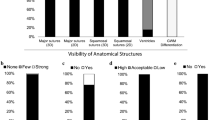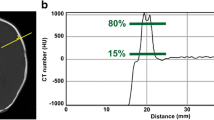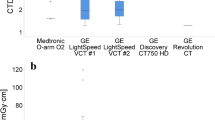Abstract
Background
Craniofacial computed tomography (CT) is the diagnostic investigation of choice for craniosynostosis, but high radiation dose remains a concern.
Objective
To evaluate the image quality and diagnostic performance of an ultra-low-dose craniofacial CT protocol with deep learning reconstruction for diagnosis of craniosynostosis.
Materials and methods
All children who underwent initial craniofacial CT for suspected craniosynostosis between September 2021 and September 2022 were included in the study. The ultra-low-dose craniofacial CT protocol using 70 kVp, model-based iterative reconstruction and deep learning reconstruction techniques was compared with a routine-dose craniofacial CT protocol. Quantitative analysis of the signal-to-noise ratio and noise was performed. The 3-dimensional (D) volume-rendered images were independently evaluated by two radiologists with regard to surface coarseness, step-off artifacts and overall image quality on a 5-point scale. Sutural patency was assessed for each of six sutures. Radiation dose was compared between the two protocols.
Results
Among 29 patients (15 routine-dose CT and 14 ultra-low-dose CT), 23 patients had craniosynostosis. The 3-D volume-rendered images of ultra-low-dose CT without deep learning showed decreased image quality compared to routine-dose CT. The 3-D volume-rendered images of ultra-low-dose CT with deep learning reconstruction showed higher noise level, higher surface coarseness but decreased step-off artifacts, comparable signal-to-noise ratio and overall similar image quality compared to the routine-dose CT images. Diagnostic performance for detecting craniosynostosis at the suture level showed no significant difference between ultra-low-dose CT without deep learning reconstruction, ultra-low-dose CT with deep learning reconstruction and routine-dose CT. The estimated effective radiation dose for the ultra-low-dose CT was 0.05 mSv (range, 0.03–0.06 mSv), a 95% reduction in dose over the routine-dose CT at 1.15 mSv (range, 0.54–1.74 mSv). This radiation dose is comparable to 4-view skull radiography (0.05–0.1 mSv) and lower than previously reported effective dose for craniosynostosis protocols (0.08–3.36 mSv).
Conclusion
In this pilot study, an ultra-low-dose CT protocol using radiation doses at a level similar to skull radiographs showed preserved diagnostic performance for craniosynostosis, but decreased image quality compared to the routine-dose CT protocol. However, by combining the ultra-low-dose CT protocol with deep learning reconstruction, image quality was improved to a level comparable to the routine-dose CT protocol, without sacrificing diagnostic performance for craniosynostosis.
Graphical Abstract




Similar content being viewed by others
Data availability
The datasets generated during and/or analyzed during the current study are available from the corresponding author on reasonable request.
References
Boulet SL, Rasmussen SA, Honein MA (2008) A population-based study of craniosynostosis in metropolitan Atlanta, 1989–2003. Am J Med Genet A 146:984–991
Johnson D, Wilkie AO (2011) Craniosynostosis. Eur J Hum Genet 19:369–376
Vannier MW, Hildebolt CF, Marsh JL et al (1989) Craniosynostosis: diagnostic value of three-dimensional CT reconstruction. Radiology 173:669–673
Kirmi O, Lo SJ, Johnson D et al (2009) Craniosynostosis: a radiological and surgical perspective. Semin Ultrasound CT MR 30:492–512
Justino H (2006) The ALARA concept in pediatric cardiac catheterization: techniques and tactics for managing radiation dose. Pediatr Radiol 36:146–153
Schweitzer T, Böhm H, Meyer-Marcotty P et al (2012) Avoiding CT scans in children with single-suture craniosynostosis. Childs Nerv Syst 28:1077–1082
Hamard A, Greffier J, Bastide S et al (2021) Ultra-low-dose CT versus radiographs for minor spine and pelvis trauma: a Bayesian analysis of accuracy. Eur Radiol 31:2621–2633
Tsiflikas I, Thater G, Ayx I et al (2023) Low dose pediatric chest computed tomography on a photon counting detector system–initial clinical experience. Ped Radiol 13:1–6
Miéville FA, Berteloot L, Grandjean A et al (2013) Model-based iterative reconstruction in pediatric chest CT: assessment of image quality in a prospective study of children with cystic fibrosis. Ped Radiol 43:558–567
Rob S, Bryant T, Wilson I et al (2017) Ultra-low-dose, low-dose, and standard-dose CT of the kidney, ureters, and bladder: is there a difference? Results from a systematic review of the literature. Clin Radiol 72:11–15
McLaughlin PD, Ouellette HA, Louis LJ et al (2013) (2013) The emergence of ultra-low–dose computed tomography and the impending obsolescence of the plain radiograph? Can Assoc Radiol J 64:314–318
Park JE, Choi YH, Cheon JE et al (2017) Image quality and radiation dose of brain computed tomography in children: effects of decreasing tube voltage from 120 kVp to 80 kVp. Pediatr Radiol 47:710–717
Niemann T, Henry S, Duhamel A et al (2014) Pediatric chest CT at 70 kVp: a feasibility study in 129 children. Pediatr Radiol 44:1347–1357
Ryu YJ, Choi YH, Cheon JE et al (2016) Knowledge-based iterative model reconstruction: comparative image quality and radiation dose with a pediatric computed tomography phantom. Pediatr Radiol 46:303–315
Montoya JC, Eckel LJ, DeLone DR et al (2017) Low-dose CT for craniosynostosis: preserving diagnostic benefit with substantial radiation dose reduction. Am J Neuroradiol 38:672–677
Barreto IL, Tuna IS, Rajderkar DA et al (2022) PEDR Pediatric craniosynostosis computed tomography: an institutional experience in reducing radiation dose while maintaining diagnostic image quality Pediatr Radiol 52:85–96
Ernst CW, Hustaert TL, Belsack D et al (2016) Dedicated sub 0.1 mSv RCT using MBIR in children with suspected craniosynostosis: quality assessment. Eur Radiol 26:892–899
Hong JH, Park EA, Lee W et al (2020) Incremental image noise reduction in coronary CT angiography using a deep learning-based technique with iterative reconstruction. Korean J Radiol 21:1165
Lim WH, Choi YH, Park JE et al (2019) Application of vendor-neutral iterative reconstruction technique to pediatric abdominal computed tomography. Korean J Radiol 20:1358–1367
Kolb M, Storz C, Kim JH et al (2019) Effect of a novel denoising technique on image quality and diagnostic accuracy in low-dose CT in patients with suspected appendicitis. Eur J Radiol 116:198–204
Vu HL, Panchal J, Parker EE et al (2001) The timing of physiologic closure of the metopic suture: a review of 159 patients using reconstructed 3-D CT scans of the craniofacial region. J Craniofac Surg 12:527–532
Deak PD, Smal Y, Kalender WA (2010) Multisection CT protocols: sex-and age-specific conversion factors used to determine effective dose from dose-length product. Radiology 257:158–166
Mazonakis M, Damilakis J, Raissaki M et al (2004) Radiation dose and cancer risk to children undergoing skull radiography. Pediatr Radiol 34:624–629
Brindhaban A, Eze CU (2006) Estimation of radiation dose during diagnostic x-ray examinations of newborn babies and 1-year-old infants. Med Princ Pract 15(2):60–265
Vassileva J, Rehani M, Kostova-Lefterova D et al (2015) A study to establish international diagnostic reference levels for paediatric computed tomography. Radiat Prot Dosimetry 165:70–80
Badve CA, Mallikarjunappa MK, Iyer RS et al (2013) Craniosynostosis: imaging review and primer on computed tomography. Pediatr Radiol 43:728–742
Vazquez JL, Pombar MA, Pumar JM et al (2013) Optimised low-dose multidetector CT protocol for children with cranial deformity. Eur Radiol 23:2279–2287
Neverauskiene A, Maciusovic M, Burkanas M et al (2018) Image based simulation of the low dose computed tomography images suggests 13 mAs 120 kV suitability for non-syndromic craniosynostosis diagnosis without iterative reconstruction algorithms. Eur J Radiol 105:168–174
Kaasalainen T, Palmu K, Lampinen A et al (2015) Limiting CT radiation dose in children with craniosynostosis: phantom study using model-based iterative reconstruction. Pediatr Radiol 45:1544–1553
Dalehaug I, Bolstad KN, Aadnevik D et al (2017) ADMIRE vs. SAFIRE: Objective comparison of CT reconstruction algorithms and their noise properties. arXiv preprint arXiv: 1708.09616. [Online]. Available: https://arxiv.org/abs/1708.09616. Accessed on Dec 7th, 2022
Acknowledgements
The authors thank Chang Won Kim for his technical support.
Funding
This research was supported by a grant of the Korea Health Technology R&D Project through the Korea Health Industry Development Institute (KHIDI), funded by the Ministry of Health & Welfare, Republic of Korea (grant number: HI20C2092).
Author information
Authors and Affiliations
Contributions
Y.H.C. designed and directed the project. Y.L., Y.H.C., S.L. and Y.J.C. interpreted the images. Y.L. analyzed the results and wrote the manuscript with supervision from Y.H.C. All authors provided critical feedback and helped shape the research, analysis and manuscript. All authors approved the final version of the manuscript.
Corresponding author
Ethics declarations
Conflicts of interest
None
Additional information
Publisher's note
Springer Nature remains neutral with regard to jurisdictional claims in published maps and institutional affiliations.
Rights and permissions
Springer Nature or its licensor (e.g. a society or other partner) holds exclusive rights to this article under a publishing agreement with the author(s) or other rightsholder(s); author self-archiving of the accepted manuscript version of this article is solely governed by the terms of such publishing agreement and applicable law.
About this article
Cite this article
Lyoo, Y., Choi, Y.H., Lee, S.B. et al. Ultra-low-dose computed tomography with deep learning reconstruction for craniosynostosis at radiation doses comparable to skull radiographs: a pilot study. Pediatr Radiol 53, 2260–2268 (2023). https://doi.org/10.1007/s00247-023-05717-3
Received:
Revised:
Accepted:
Published:
Issue Date:
DOI: https://doi.org/10.1007/s00247-023-05717-3




